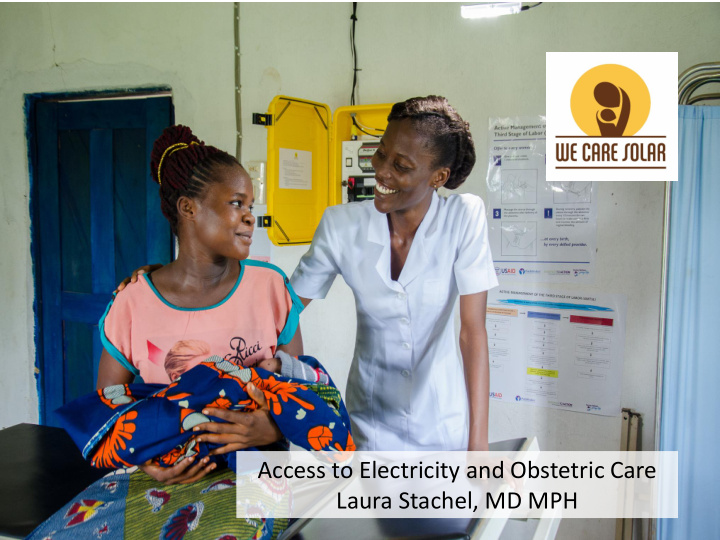



Access to Electricity and Obstetric Care Laura Stachel, MD MPH
CASE STUDY: LATRINES IN CAMBODIA AFTER Installation BEFORE Solar Suitcase • • Greater uptake of skilled care by mothers Fear of night duty • • Improved health worker morale & Difficulty with diagnosis and treatment • Difficulty monitoring fetal well-being confidence • • Improved capacity to provide obstetric care Emergency communication hindered • • Reduced delays – prompt c/sections Delayed and cancelled procedures • Accurate fetal heart rate monitoring including cesarean sections • • Timely referrals Safety concerns
Multi-Intervention Studies Solar Suitcase Programs with Multiple Interventions Maternal Mortality Perinatal Mortality ↓ 53 % ↓ 73 % 100 facilities Uganda Saving Lives at Birth (Amref) 2013 - 2016 ↓ 40 % ↓ 46 % 78 Facilities Tanzania Mobilizing Maternal Health Project 2014 – 2017 (Pathfinder) ↓ 55 % ↓ 40 % 60 Facilities Nigeria Cross River State Program (Pathfinder) Saving Mothers Giving Life 2017-2018
RCT CT in Uganda • Third party research lead by Innovations for Poverty Action and Harvard School of Public Health • Funded by UBS Optimus Foundation • Stepped wedge cluster-randomized control trial in 30 maternity care facilities in rural Uganda that lack access to reliable lighting • Facilities randomized into one of two groups of 15 facilities • Timing of implementation staggered → All facilities eventually receive the Solar Suitcase • All are observed before and after intervention
Design and Data Collection Methods • Installed light sensors (1) Reliability and quality of light • Light and electricity during intrapartum care observation • Direct clinical observations Primary Outcomes (2) Quality of obstetric and by trained enumerators newborn care • Facility survey • (3) Health worker satisfaction Health worker survey • (4) Facility volumes (# deliveries, Quarterly visits to facilities Secondary Outcome deaths, ANC visits, etc.) to collect HMIS data
Enroll facilities meeting eligibility criteria Enroll facilities meeting eligibility criteria
Implementation Challenges • Government selected districts: Hard to find facilities meeting all eligibility criteria → Delayed start of project • Observations did not always verify study eligibility • Confounding variables • RCT as part of the Light Every Birth Initiative Uganda
Strengths Limitations • Randomized Design • Limited Number of Facilities • Direct Clinical Observations • Rural Ugandan health and time stamping for delays rather than self- facilities only report • Not examining surgical care • Detailed observation tool and complicated labors • Objective and Subjective Light Assessments
Baseline Data • 30 facilities; 73% HC IIIs, 17% HC IIs, 10% HCIVs • 37% grid connection; 23% solar; 40% no electricity • 419 observations of labor and delivery • 43% exclusively night observations, 21% daytime, and 36% combine night and day • 59% of health workers rated availability of light as poor/very poor • Baseline quality of care: An average of 45% of essential items were performed • Without good lighting, episiotomy repair delayed
Recommend
More recommend